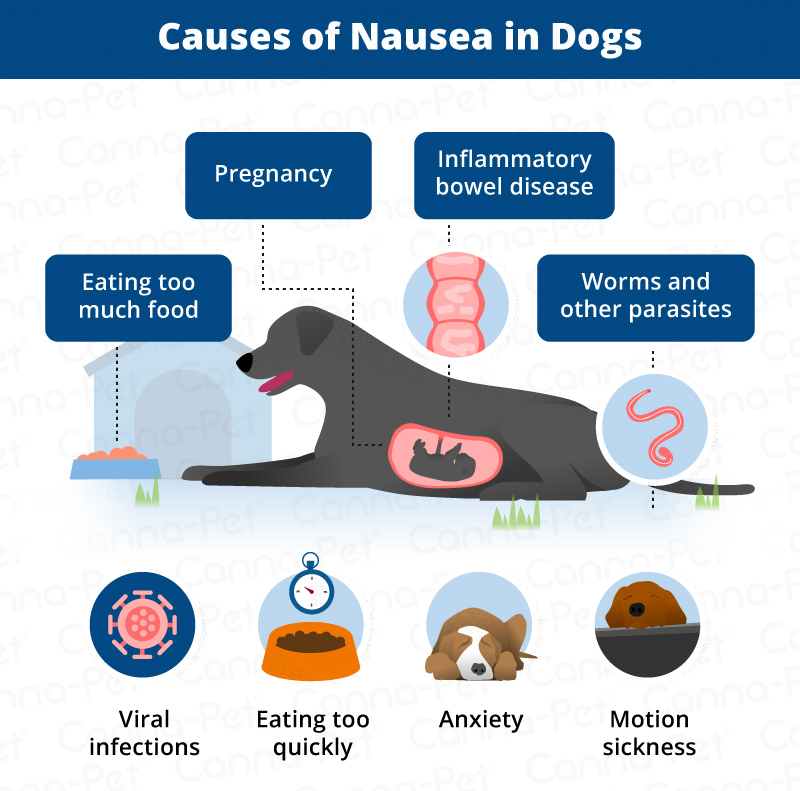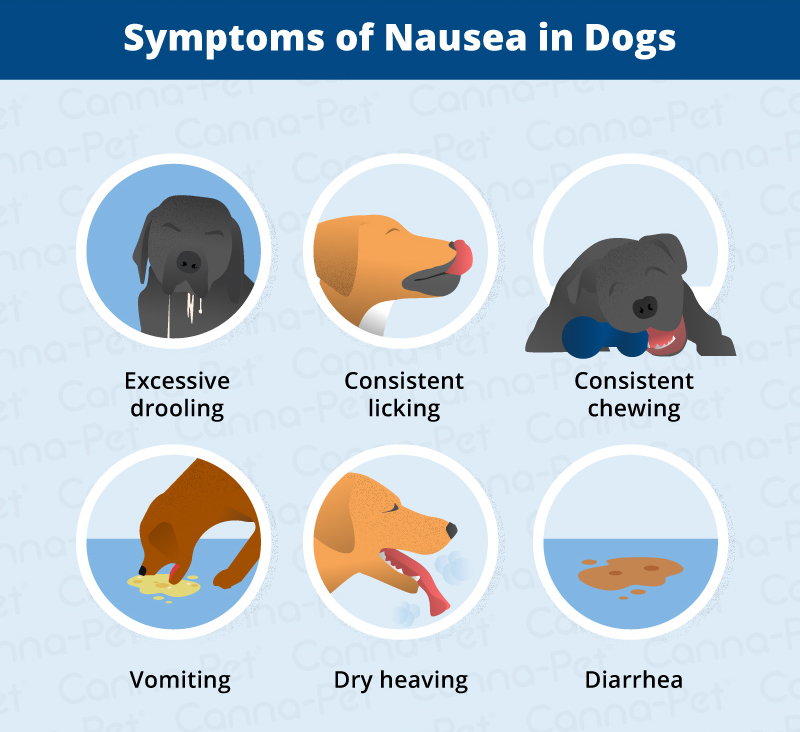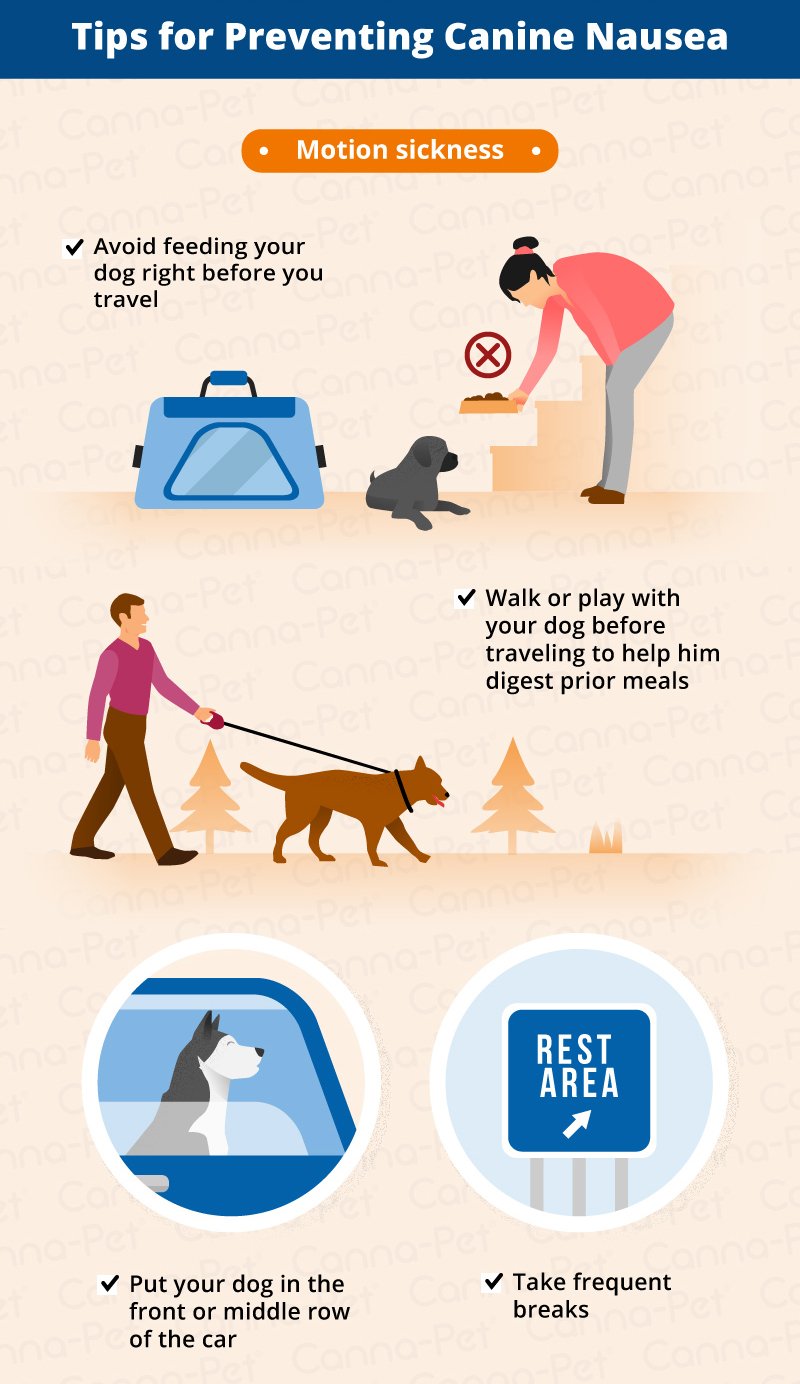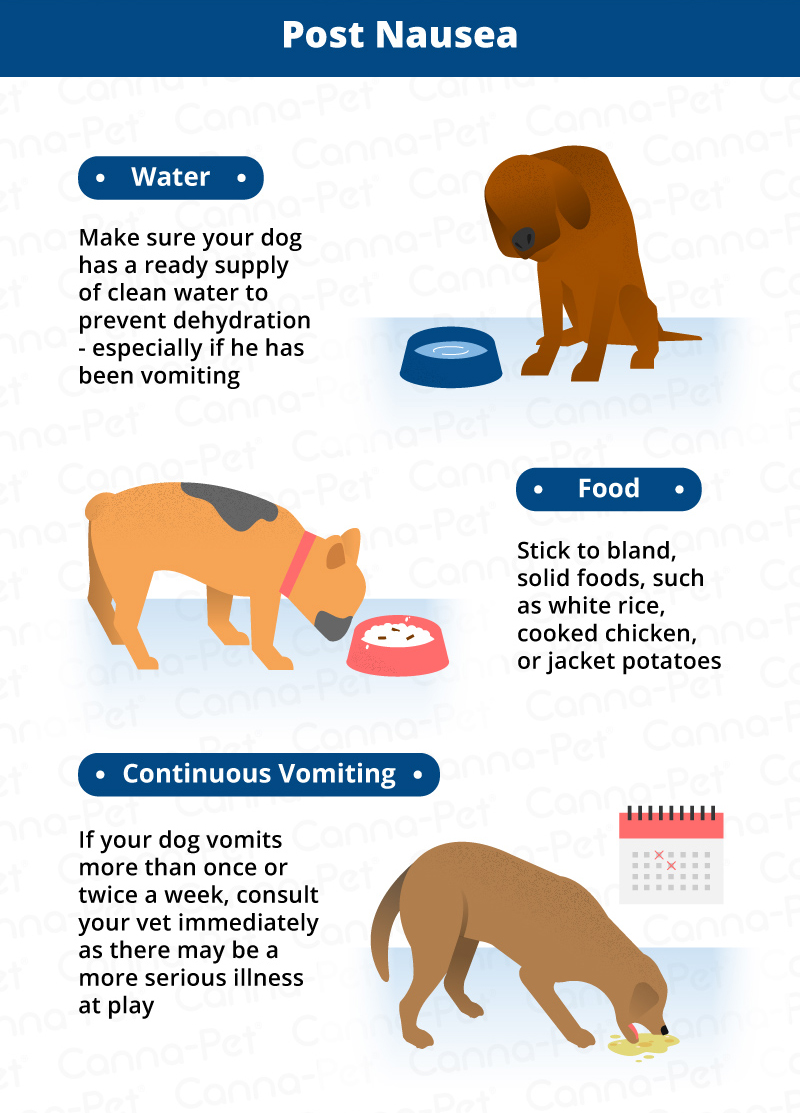Dogs are resilient, loveable animals who have been a part of human history for centuries. According to Archaeology Magazine, the earliest potential dog remains, first excavated from the Goyet Cave in Belgium, can be dated as far back as 31,700 years ago. For certain, dogs have been around for at least 10,000 years, playing a vital role in early humans’ hunting, rituals, and general companionship.
While it seems like dogs can eat just about anything and survive just fine, they can experience nausea just like you. Let’s a closer look at dog nausea, what causes it, and some natural remedies to help ease the symptoms.
The Mechanisms of Dog Nausea
As common as nausea is in dogs, properly diagnosing and treating nausea in dogs can be difficult. That’s because it’s generally a subjective experience that involves emotional, physical, and physiological symptoms. While humans can often tell you when they’re feeling nauseous, dogs can’t exactly speak up about how they’re feeling until they’re already vomiting. This has made it difficult for researchers to properly study nausea in animals.
Objective means of measuring nausea can prevent proper diagnosis. More often, it comes down to any abnormal or sudden irregular behaviors you notice in your pup.
Causes of Nausea in Dogs
Nausea in dogs can be caused by a wide range of factors. Much like nausea in humans, dog nausea is often diet-related. This could be anything from eating too much food or eating too quickly to changing your dog’s diet or feeding them something they shouldn’t have eaten. Dogs can also suffer nausea as a result of motion sickness, like from riding a car or chasing a tail.
Other common causes of nausea in dogs include:
- Pregnancy
- Worms and other parasites in the intestines
- Anxiety, including separation anxiety
- Viral infections
- Inflammatory bowel disease
Nausea isn’t breed specific, so from Boston Terrier to Newfoundlands, you can expect generally the same chance of your dog succumbing to nausea. However, you can expect older dogs to be more susceptible to nausea than younger pups.
Symptoms of Nausea in Dogs
To be clear, nausea is a symptom in itself that could point to other conditions, but it does come with certain signs and symptoms, including:
- Excessive drooling
- Consistent licking
- Consistent chewing
- Dry heaving
Nausea is most commonly noted by vomiting or diarrhea. Remember that nausea can point to a more serious condition. Isolated incidents of vomiting are common in a dog’s life and aren’t always a cause for concern. As long as your dog maintains a good appetite and isn’t uncharacteristically lethargic, you shouldn’t have to worry too much. However, consistent diarrhea or vomiting can point to a sick dog. Thankfully, there are numerous natural remedies that can soothe your dog’s nausea and help it feel better.
Tips for Preventing Canine Nausea
It’s hard to always nail down when your dog’s nausea will hit or what triggers nausea in your dog, but you can take specific steps to keep your dog from succumbing to nausea. For instance, avoid feeding your dog immediately before car travel, and consider walking or playing with your dog before getting into the car to help your dog digest any prior meals.
When in the car, try to position your dog in the front or middle row of the car. Rear compartments tend to provide bumpier, more uneven rides. Take frequent breaks so that your pup can stretch its legs, go to the bathroom, drink water, and relieve and pent up stress or anxiety.
In terms of food, try to stick with good old fashioned dog food. Avoid:
- Spoiled food
- Food that has been in the fridge for more than 3 days
- Eating food rich in fats
- Sweets
- Processed meats
- Seafood
If your dog experiences nausea from eating food too fast, consider providing smaller amounts of food more often or mixing dry food with water. You may also consider splitting individual meals, providing half the food, waiting fifteen minutes, and pouring the second half of food.
Natural Remedies and Treatments for Dog Nausea
Veterinarians commonly use a variety of prescription medications to help dogs with nausea, however you can also give your dog natural remedies that can be equally as effective. Common medications include Cerenia for dogs, Metoclopramide, and Famotidine or Pepcid. Much like with humans, feeding your dog homemade food that’s easy on the stomach is another great solution. Foods like rice, boiled potatoes, and plain chicken can help vomiting and nausea. Natural remedies are often equally effective and can be used for dogs with sensitivities to medications. Common natural remedies include the following:
- Baking soda and water
- Hemp Supplements
- Kefir
- Lavender Oil
- Catnip
- Ginger
- Peppermint
- Acidophilus Probiotic
- Slippery Elm
Baking Soda and Water
It’s not the fanciest of remedies, but the simplicity of baking soda and water is exactly why it works. The bubbles can calm the stomach and help reduce bloating and feelings of nausea. Add a teaspoon of baking soda to a half cup of water. Give your dog a few sips of this mixture every two hours or so.
Hemp Supplements
Many people go to their pets looking for what they can give their dog for nausea and vomiting. Hemp supplements, like Canna-Pet CBD for cats and dogs, have shown to reduce nausea and vomiting while offering a wide range of potential health benefits. Some of these benefits include:
- Pain relief
- Anxiety relief
- Reduced inflammation
- Improved skin condition
- Nervous system support
- Reduced digestive tract issues
Provide hemp supplements as recommended on the label.
Kefir
Kefir is a fermented milk beverage that, much like yogurt, offers beneficial probiotics, which are gut bacteria that can aid in digestion and general health. While regular milk can potentially irritate your dog’s intestinal tract, often leading to upset stomach, kefir can strengthen your pup’s digestive system.
You can buy kefir on its own or convert regular milk to kefir using kefir starter granules. Simply pour a half packet of the granules into a quart of organic, unpasteurized milk and leave overnight.
After your dog vomits, provide some kefir once an hour for about three hours. For small dogs, provide 1 to 2 teaspoons. Medium dogs can have up to 2 tablespoons, while larger dogs can have up to 4 tablespoons. Once your dog’s tummy has been soothed by kefir, you can make it a regular part of his diet by adding up to 3 teaspoons of it to your dog’s food. This can improve your dog’s gut defenses, potentially reducing the potential for nausea.
Lavender Oil
In a study published in the Journal of the American Veterinary Medical Association, researchers found that the ambient smell of lavender helped reduce over-excitement in dogs during travel. In the results, dogs exposed to the smell of lavender spent less time in an excitable state of moving and vocalizing and more time sitting and resting.
This can be a big help for dogs who get nauseous during car rides. Add a drop of lavender oil to your dog’s collar, or soak a cotton ball in lavender oil and leave it in your dog’s general vicinity.
Catnip
Known for providing cats with a distinct sense of euphoria, catnip isn’t just for the felines. It can offer similar soothing, happy feelings for dogs, helping to calm upset stomachs. Create a simple catnip glycerin tincture by soaking catnip in filtered water and food-grade vegetable glycerin for a few weeks.
When your dog experiences nausea or vomiting, drop about 12 to 20 drops for every 20 pounds of your dog’s weight into their food or water bowl.
Ginger
When you were younger, your mother may have prescribed some ginger ale to soothe your upset stomach. Ginger is a powerful root that can calm your upset stomach, among many other potential benefits. In dogs, it can reduce nausea and motion sickness and prevent bronchitis, heart disease, and colitis.
Ginger is available in capsules, ensuring calm, restful car rides, but consult your vet for dosage amounts. If you provide raw ginger, generally keep it to smaller amounts. Too much ginger can cause heartburn and actually lead to more upset stomach. Ginger is also available as an essential oil. You may also consider making or buying dog treats that contain ginger in them, which makes it much more scrumptious for your pup.
You can also try our all-natural CBD dog treats that are not only tasty treats for your dog but also provide potential CBD benefits.
Dogs are also a big fan of ginger tea. Drop a teaspoon of ginger powder or 1 tablespoon of grated ginger into a pot with a half cup of coconut milk. Simmer for 10 minutes. Give your pup 1 to 3 teaspoons of the ginger tea ever 1 or 2 hours.
Peppermint
Peppermint is most well known for helping to freshen the breath, which can be a big help in of itself if your dog’s breath is smelling a little fishy. However, peppermint is also commonly used by humans to aid in digestion. It can help calm nausea and car sickness and regulate peristalsis to help fight symptoms of irritable bowel syndrome and inflammatory bowel disease.
You can find peppermint tinctures for kids in health food stores or try the methods mentioned above to make a concentrated peppermint solution of your own. Follow the label and dose by body weight.
Thankfully, most dogs enjoy the taste of peppermint, so getting them to take it shouldn’t be a problem. Try offering them a weak, diluted peppermint tea in a bowl. Make sure the tea is lukewarm or room temperature to avoid any burnt snouts. Avoid peppermint if your dog experiences acid reflux.
Acidophilus
Lactobacillus acidophilus is another probiotic consisting of bacteria that naturally occurs in a dog’s body, generally focused on the intestines. Along with easing nausea and issues with digestion, acidophilus can help to
- Improve your dog’s immune system
- Provide a shinier coat
- Prevent shedding
- Eliminate bad breath and flatulence
- Counteract the side effects of strong antibiotics
- Relieve arthritic pain
Acidophilus is easily obtainable as a supplement from your local pet supply store, though it can also be found in low fat and low sugar plain yogurt. A teaspoon of yogurt added to your dog’s food can provide all the good bacteria it needs.
Supplements can also be mixed with food, but the dosage differs based on the number of live acidophilus organisms contained within the supplement. Most vets recommend a daily intake of 20 million to 500 million organisms. Read the label and talk to your vet if you’re not sure.
Slippery Elm
Slippery elm, also known by its scientific name Ulmus rubra, is a type of elm tree native to various parts of North America. It is available as a supplement for dogs and is something of a cure-all for digestive problems, including nausea, upset stomach, diarrhea, and loose stools.
While you can find slippery elm in the form of a tablet or capsule, go for the loose powder form, which allows for easier dosage and modification. You can mix it with warm water, forming the slippery elm into a gelatinous consistency. From there, you can feed your dog the mixture alone or combine it with food. Thanks to its slightly sweet taste, your pup shouldn’t have a problem consuming it either way.
Post-Nausea
Your dog’s nausea should generally subside on its own after a couple hours or after vomiting. Regardless, make sure your dog has a ready supply of clean water, especially if he has been vomiting. Vomiting forces a lot of water out of the dog’s body. This can potentially lead to dehydration, which could spell numerous other, more serious problems for your dog.
In terms of food after vomiting, try to stick with bland, solid foods, including white rice, cooked chicken, or jacket potatoes. You may combine these with peppermint or ginger tea suggested above.
If your dog vomits more than once or twice a week for over a week or continues to show signs of nausea or lethargy for a few days, consult your vet. There may be something more serious causing his illness. For example, his nausea combined with a dull coat and round belly might point to possible parasites or worms. As always, before introducing something new to your dog’s diet or using a new home remedy, consult your vet for guidance and information.
Canna-Pet Success Story: Beppe
Meet Beppe! Before trying Canna-Pet®, Beppe would vomit constantly. His owner gave Canna-Pet a try and reports that it “has been wonderful for Beppe’s very fragile little stomach.” Whenever Beppe vomits, his owner simply gives him a Canna-Pet biscuit and the vomiting clears right up!
Complete Dog Nausea Infographic
Share this Image On Your Site
Sources:
- “Vomiting in Dogs: Causes and Treatment.” WebMD, Accessed 12 July 2015. www.pets.webmd.com/dogs/vomiting-dogs-causes-treatment.
- “Dog Nausea Diagnosis and Treatment.” VetInfo, Accessed 12 July 2015. www.vetinfo.com/dog-nausea-diagnosis.html.
- Normann, Igor. “Five Remedies for Upset Stomach in Dogs.” PetMD, Accessed 12 July 2015. www.petmd.com/dog/wellness/evr_dg_remedies-for-upset-stomach-in-dogs.
- “Nauseous in Dogs – Definition, Cause, Solution, Prevention, Cost.” Wag Walking, 2 June 2017, Accessed 12 July 2015. www.wagwalking.com/symptom/why-is-my-dog-nauseous.
- Schenker, Michelle. “Tips To Cure Your Dog’s Upset Stomach.” CanineJournal, 7 Aug. 2018, Accessed 12 July 2015. www.caninejournal.com/cure-dogs-upset-stomach/.












